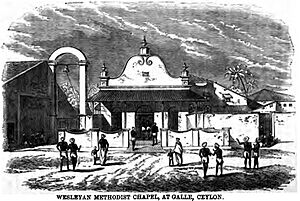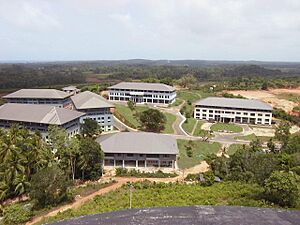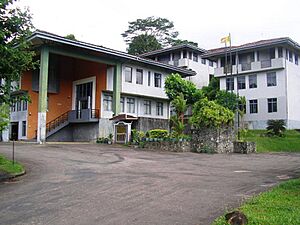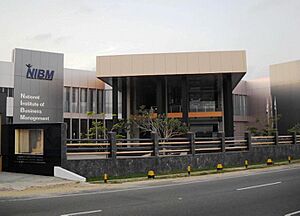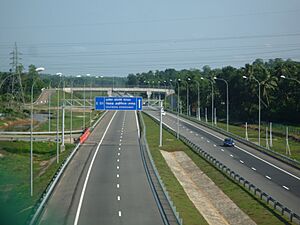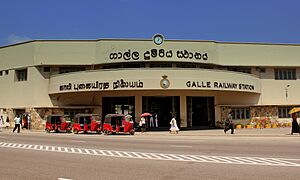Galle facts for kids
Quick facts for kids
Galle
ගාල්ල
காலி |
|
|---|---|
| City of Galle | |
|
Aerial view of Galle Fort
Galle International Stadium
Galle railway station
Unawatuna beach
Peace Pagoda in Galle
Maritime Museum of Galle
Rumassala
|
|
| Country | Sri Lanka |
| Province | Southern Province |
| Government | |
| • Type | Galle Municipal Council |
| Area | |
| • Total | 16.52 km2 (6.38 sq mi) |
| Elevation | 0 m (0 ft) |
| Population
(2020)
|
|
| • Total | 93,118 |
| • Density | 5,712/km2 (14,790/sq mi) |
| Demonym(s) | Galleans |
| Time zone | UTC+5:30 (Sri Lanka Standard Time Zone) |
| Area code(s) | 091 |
| Website | galle.mc.gov.lk |
| UNESCO World Heritage Site | |
|---|---|
| Criteria | Cultural: iv |
| Inscription | 1988 (12th Session) |
Galle is a big city in Sri Lanka, located on the southwestern tip of the island. It's about 119 kilometers away from Colombo, the capital city. Galle is the main city and capital of the Southern Province, Sri Lanka and the Galle District.
Long ago, before the Portuguese arrived in the 1500s, Galle was known as Gimhathiththa. It was the most important port in Sri Lanka. A traveler named Ibn Batuta from Morocco visited in the 1300s and called it Qali. Galle grew a lot in the 1700s when the Dutch controlled the area.
Galle is famous for its strong fortress, which was first built by the Portuguese. The Galle fort was made even stronger by the Dutch in the 1600s. It's now a World Heritage Site and is the biggest fort in Asia built by European powers that is still standing.
Other important places in Galle include its natural harbor, the National Maritime Museum, and St. Mary's Cathedral. There's also a main Shiva temple and a historic luxury hotel called Amangalla. In 2004, a huge tsunami hit the city, causing a lot of damage and loss of life.
Galle is also home to the Galle International Stadium, a very beautiful cricket ground. The stadium was badly damaged by the tsunami but was rebuilt. Cricket matches started again there in 2007.
Natural spots in Galle include Rumassala in Unawatuna, a large hill that protects Galle Harbour. Local stories connect this hill to the ancient Hindu epic, Ramayana. The main river in the area is the Gin Ganga, which flows into the sea at Gintota.
Contents
- What's in a Name? The Etymology of Galle
- A Journey Through Time: The History of Galle
- Galle's Weather: A Tropical Climate
- City Layout: Wards of Galle
- How Galle is Governed
- Who Lives in Galle: Demographics
- Learning in Galle: Education
- Getting Around: Transport in Galle
- Global Connections: Twin Cities
- See also
What's in a Name? The Etymology of Galle
Galle was called Gimhathitha a long time ago. This name might come from an old Sinhalese phrase meaning "port near the River Gin."
Some people think the local name Gaalla came from the many bullock carts that rested there after long journeys. In Sinhala, Gaala means a place where cattle gather.
Another idea is that the name Galle comes from the Latin word gallus or the Portuguese word galo, both meaning 'rooster'. The Dutch, who ruled Galle later, even used a rooster as a symbol for the city.
A Journey Through Time: The History of Galle
Ancient Connections and Early Trade
Historians believe Galle might have been the ancient port of Tarshish. From here, King Solomon received valuable goods like ivory and peacocks. Cinnamon was traded from Sri Lanka as early as 1400 BC, and Galle might have been a key trading spot for this spice.
Ancient Greek and Roman mapmakers may have known about Galle. They might have called it the Cape of Birds. The traveler Ibn Battuta visited Galle in 1342. In the 1100s and 1200s, people from the south of Sri Lanka began to settle in Galle.
Galle was a busy seaport long before European rule. Traders from Persia, Arabs, Greeks, Romans, Malays, Indians, and Chinese all did business through Galle's port. In 1411, a special stone tablet called the Galle Trilingual Inscription was placed in Galle. It was written in three languages: Chinese, Tamil, and Persian. This tablet marked the second visit to Sri Lanka by the famous Chinese admiral Zheng He.
European Influence and the Fort
In 1502, a small fleet of Portuguese ships, led by Lourenço de Almeida, accidentally landed in Galle due to a storm. They soon realized the King lived in Kotte, near Colombo, and went there after a short stop in Galle.
In 1640, the Dutch East India Company took over Galle from the Portuguese. The Dutch then built the strong Galle Fort that we see today in 1663. They built thick granite walls and three large bastions, which they named "Sun," "Moon," and "Star."
When the British took control of Sri Lanka from the Dutch in 1796, they kept the fort just as it was. They used it as the main administrative center for the area.
Galle's Weather: A Tropical Climate
Galle has a tropical rainforest climate. This means it's warm and humid all year round, with lots of rain. There isn't a true dry season, though January and February are a bit drier. Temperatures don't change much throughout the year, usually staying around 26 degrees Celsius.
| Climate data for Galle (1991–2020 normals) | |||||||||||||
|---|---|---|---|---|---|---|---|---|---|---|---|---|---|
| Month | Jan | Feb | Mar | Apr | May | Jun | Jul | Aug | Sep | Oct | Nov | Dec | Year |
| Record high °C (°F) | 34.9 (94.8) |
34.6 (94.3) |
36.4 (97.5) |
35.5 (95.9) |
35.3 (95.5) |
32.6 (90.7) |
31.5 (88.7) |
31.3 (88.3) |
31.2 (88.2) |
33.2 (91.8) |
33.8 (92.8) |
33.5 (92.3) |
36.4 (97.5) |
| Mean daily maximum °C (°F) | 29.9 (85.8) |
30.7 (87.3) |
31.6 (88.9) |
31.4 (88.5) |
30.4 (86.7) |
29.4 (84.9) |
29.0 (84.2) |
29.0 (84.2) |
29.2 (84.6) |
29.4 (84.9) |
29.9 (85.8) |
29.9 (85.8) |
30.0 (86.0) |
| Daily mean °C (°F) | 26.7 (80.1) |
27.2 (81.0) |
28.1 (82.6) |
28.4 (83.1) |
28.2 (82.8) |
27.5 (81.5) |
27.1 (80.8) |
27.2 (81.0) |
27.2 (81.0) |
27.1 (80.8) |
27.1 (80.8) |
26.8 (80.2) |
27.4 (81.3) |
| Mean daily minimum °C (°F) | 23.4 (74.1) |
23.7 (74.7) |
24.6 (76.3) |
25.3 (77.5) |
26.0 (78.8) |
25.7 (78.3) |
25.4 (77.7) |
25.4 (77.7) |
25.2 (77.4) |
24.8 (76.6) |
24.2 (75.6) |
23.7 (74.7) |
24.8 (76.6) |
| Record low °C (°F) | 18.7 (65.7) |
19.4 (66.9) |
17.1 (62.8) |
18.2 (64.8) |
17.1 (62.8) |
20.7 (69.3) |
20.9 (69.6) |
20.9 (69.6) |
20.4 (68.7) |
20.7 (69.3) |
18.1 (64.6) |
18.9 (66.0) |
17.1 (62.8) |
| Average precipitation mm (inches) | 86.8 (3.42) |
71.1 (2.80) |
89.9 (3.54) |
201.9 (7.95) |
315.9 (12.44) |
184.0 (7.24) |
172.6 (6.80) |
161.9 (6.37) |
260.9 (10.27) |
344.5 (13.56) |
282.6 (11.13) |
175.9 (6.93) |
2,348 (92.44) |
| Average precipitation days (≥ 1.0 mm) | 6.6 | 5.8 | 6.9 | 11.8 | 17.2 | 16.6 | 15.1 | 14.2 | 17.1 | 18.2 | 14.9 | 11.2 | 155.7 |
| Source 1: NOAA | |||||||||||||
| Source 2: Department of Meteorology (records up to 2007) | |||||||||||||
City Layout: Wards of Galle
Galle is divided into twenty smaller areas called wards. These include:
- Gintota
- Dadalla
- Bope
- Kumbalwella
- Madawalamulla
- Deddugoda
- Maitipe
- Dangedara
- Bataganvila
- Sangamiththapura
- Galwadugoda
- Kandew
- Galle Town
- Weliwaththa
- Thalapitiya
- Makuluwa
- Milidduwa
- Magalle
- Katugoda
- Imaduwa
How Galle is Governed
The city of Galle is managed by the Galle Municipal Council. This council was set up in 1865 and was one of the first municipal councils in Sri Lanka. The first mayor of Galle was Wijeyananda Dahanayake, who later became the fifth Prime Minister of Ceylon.
Currently, a commissioner manages the city. Galle has a goal to become a "Green City-Green Galle." This means they want to make Galle a cool and healthy coastal city with lots of clean, green spaces.
Who Lives in Galle: Demographics
Galle is a fairly large city with a population of about 101,749 people. Most of the people living in Galle are Sinhalese. There is also a large group of Sri Lankan Moor (Muslim) people, especially around the fort area. These Muslim residents are descendants of Arab merchants who settled in Galle long ago and married local women. Galle also has a noticeable number of foreign residents and people who own holiday homes there.
| Ethnicity in Galle (2012) | ||||
|---|---|---|---|---|
| Population | Percent | |||
| Sinhalese | 65.69% | |||
| Muslims | 32.30% | |||
| Tamils | 0.71% | |||
| Others | 1.3% | |||
Learning in Galle: Education
Schools in Galle
Galle is home to some of the oldest and best schools in Sri Lanka. The city has 29 government schools and 5 international schools. Here are some of the schools in Galle:
| School | Date of establishment |
|---|---|
| All Saints College | 1867 |
| Anula Devi Balika Vidyalaya | 1941 |
| British College Sri Lanka | 1900 |
| Buona Vista College | 1888 |
| Ceylinco Sussex College | 1997 |
| Galle International College | 2011 |
| Kingston International School | 1900 |
| Leeds International School | 2007 |
| Mahinda College | 1892 |
| Malharus Sulhiya National College | 1918 |
| Muslim Ladies College | 2001 |
| Olcott Maha Vidyalaya Galle | 1937 |
| Richmond College | 1876 |
| Rippon Girls' College | 1817 |
| Sacred Heart Convent | 1896 |
| St. Aloysius' College | 1895 |
| Sanghamitta Girls College | 1919 |
| Siridhamma College | 1995 |
| Sudharma College | 1895 |
| Southlands College Galle | 1885 |
| Thomas Gall International School | 2006 |
| Vidyaloka College | 1941 |
| Janadhipathi Balika Vidyalaya | 2007 |
Universities in Galle
Three main parts of the University of Ruhuna are located in Galle. The Faculty of Engineering is about 6 kilometers from the city center. The Faculty of Medicine is near the Karapitiya Teaching Hospital. The Faculty of Allied Health Sciences is also within the city limits. The Open University of Sri Lanka also has a study center in Galle.
- Faculty of Engineering, University of Ruhuna
- Faculty of Medicine, University of Ruhuna
- Faculty of Allied Health Sciences, University of Ruhuna
- Study Centre, Open University of Sri Lanka
Higher Education Institutes
The Advanced Technological Institute (ATI) in Labuduwa, Galle, started in 2000. It offers higher national diplomas in Information Technology and Agriculture Technology. The National Institute of Business Management (NIBM) in Galle opened in 2010. It provides higher education in information technology and business management.
The Ruhunu National College of Education trains teachers for government schools. The Amarasuriya Teachers' Training College also trains government school teachers.
- Advanced Technological Institute (ATI)
- National Institute of Business Management (NIBM)
- Ruhunu National College of Education
- Amarasuriya Teachers' Training College
- Mercantile Seamen Training Institute (MSTI)
Getting Around: Transport in Galle
Galle is connected by train through Sri Lanka Railways' Coastal Line. You can travel by train to Colombo and Matara. The Galle Railway Station is a major stop on this line.
The A2 highway, also known as the Galle Road, goes through the city. It connects Galle to Colombo along the west coast and to Hambanthota along the south coast.
The Southern Expressway is Sri Lanka's first major highway. It links Colombo with Galle, cutting travel time from three hours to just one hour.
Global Connections: Twin Cities
Galle has a special connection with another city around the world. It is twinned with:
 Velsen, Netherlands
Velsen, Netherlands
See also
 In Spanish: Galle para niños
In Spanish: Galle para niños










